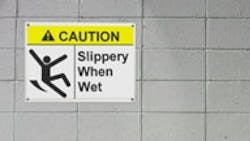It may be tempting when in a rush to take a permanent marker and quickly scrawl and post a handwritten “Wet Floor” sign, but think twice. When school maintenance personnel improvise workplace signs, they can face non-compliance fines from OSHA, scrutiny from management and co-workers, and the great likelihood of misunderstandings that can lead to some potentially dangerous situations.
Pay attention: Neither ANSI nor OSHA allows handwritten danger, warning or caution signs. ANSI and OSHA criteria were established to make workplaces safer.
Think about it. Even if a school maintenance person has very legible handwriting, it can be difficult or impossible to tell a G from a 6. Or see the subtle difference between I, l, 1 and /. Other problematic characters include C, (, O, 0, g, q, u, v, U, V, + and t. These subtleties make it impossible to perform fairly basic tasks like product placement or file organizing, and they can be potentially dangerous if the sign includes an important hazard warning that needs to be comprehended instantly.
In fact, ANSI Z535.2-2007 and ANSI Z535.4-2007, which covers the criteria for safety signage, specifically state that only typed, sans-serif lettering can be used such as Arial, Folio, Franklin Gothic, Helvetica, Meta, News Gothic, Poster Gothic, and Univers.
Although the primary failing of hand-written signs is legibility, another major problem often is overlooked: Handwritten signs cannot contain safety symbols. And often, symbols are more important than words on a sign— especially for non-English speakers.
Post It
There’s a viable alternative to handwritten signs and labels in the workplace offering all the do-it-yourself benefits school maintenance managers enjoy. Desktop and handheld workplace printers enable users to create and print legible and compliant signs and labels in a wide variety of fonts and sizes on numerous types of supplies with an ever-growing library of safety symbols, including custom-designed pictograms. Technology also is available for school maintenance employees to cut and paste photos, symbols and graphics.
Recent updates to the ANSI standards have been deliberately brought in line with the international standards provided by ISO. Interestingly, ISO 7001:2007 actually requires safety signs to have a greater emphasis on the symbol than on the actual words. According to ISO, symbols fall into two basic categories:
Graphical Symbols: visually perceptible figures with a particular meaning used to transmit information independently of language.
Public information symbols: graphical symbols intended to give information to the general public, the understanding of which is independent of specialist or occupational training.
Both types are intended to make sure that everyone, regardless of their native language, can easily and quickly avoid hazardous situations.
Following this lead, ANSI overhauled its criteria for safety symbols, stating that the purpose is “to promote the adoption and use of uniform and effective safety symbols for safety communication.”
Workplace safety and compliancy are closely aligned, so school signage and labels should support all the changes and updates OSHA, ANSI and ISO present for years to come.
Stephenson is a managing partner at Graphic Products, Inc., Beaverton, Ore.
